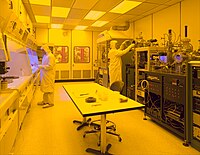
Photo from wikipedia
Abstract The use of biodegradable biopolymers such as cellulose as a suitable adsorbent, is a sustainable solution for the treatment of heavy metal contaminated waters. In this study, treated biomass… Click to show full abstract
Abstract The use of biodegradable biopolymers such as cellulose as a suitable adsorbent, is a sustainable solution for the treatment of heavy metal contaminated waters. In this study, treated biomass (relatively pure cellulose) was obtained from agricultural wastes in a completely new and applicable method using ultrasonic. Then, the treated biomass was incorporated in alginate matrix and alginate/treated biomass bead was successfully fabricated via a facile glutaraldehyde cross-linking reaction and coagulation-solidification method. The prepared bead was characterized and used as an efficient biosorbent for lead removal from aqueous solutions. The maximum experimental adsorption capacity of the adsorbent was obtained 206.75 mg/g at C0 = 210 mg/L, T =328 K, and pH = 5. The experimental kinetic and equilibrium data were well adjusted with pseudo-second-order kinetic and Freundlich isotherm models, respectively. The adsorption mechanism investigations illustrated that electrostatic interactions are responsible for metal ion adsorption and the rate-limiting step of the adsorption in the early stages was film diffusion.
Journal Title: Industrial Crops and Products
Year Published: 2021
Link to full text (if available)
Share on Social Media: Sign Up to like & get
recommendations!